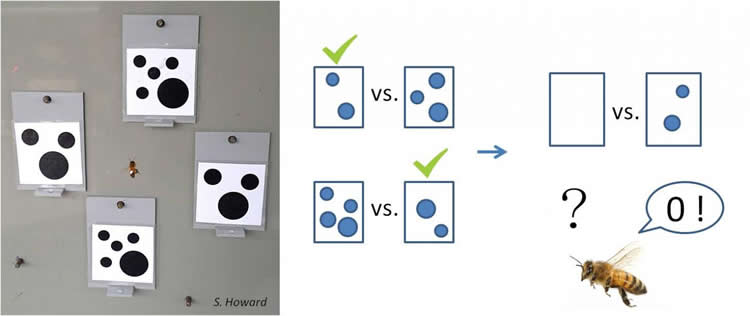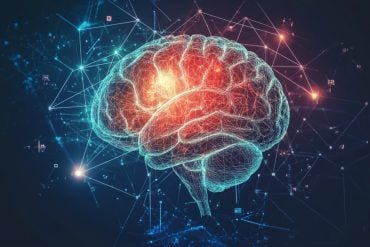Summary: Researchers reveal bees are able to grasp complex numerical concepts, such as the value of zero.
Source: CNRS.
Though some vertebrates had already been shown to master complex numerical concepts like addition and zero, no evidence of this existed for insects. Since bees can count to five at least, the researchers taught them the inequality relations “greater than” and “less than.”
First they trained them to drink sweetened water from an experimental setup where platforms were paired with images. Their task was simply to choose the image depicting the smallest number of elements. If they selected the correct one, they were rewarded with sweetened water. Otherwise, they got bitter quinine solution. Once the bees grasped the exercise, the researchers showed them two images at a time: one was blank (representing zero) and another had one or more dots (representing a whole number). The insects selected the blank image as representing the least number of elements. This shows they had extrapolated their understanding of “less than”–as applied to whole numbers (1, 2, 3, 4, or 5)–to zero, which they assigned the lowest rank of all.

Bees have only a million neurons (100,000 times fewer than humans), yet both species can grasp zero. Zero was a major mathematical breakthrough for humans and is a particularly abstract concept. We can use this symbol of “nothing” to designate the absence of objects, while manipulating it as if it represented a quantity. The brain, which evolved to process sensory stimuli, can also perceive the absence of stimuli as a construct itself. By suggesting that the concept of zero is useful even to pollinating insects, the scientists’ discovery invites inquiry into its symbolic importance more generally.
Source: Juliette Dunglas – CNRS
Publisher: Organized by NeuroscienceNews.com.
Image Source: NeuroscienceNews.com image is credited to Scarlett Howard & Aurore Avarguès-Weber.
Original Research: Abstract for “Numerical ordering of zero in honey bees” by Scarlett R. Howard, Aurore Avarguès-Weber, Jair E. Garcia, Andrew D. Greentree, and Adrian G. Dyer in Science. Published June 8 2018
doi:10.1126/science.aar4975
[cbtabs][cbtab title=”MLA”]CNRS “Bees and the Thought of Naught.” NeuroscienceNews. NeuroscienceNews, 8 June 2018.
<https://neurosciencenews.com/insect-bee-math-9294/>.[/cbtab][cbtab title=”APA”]CNRS (2018, June 8). Bees and the Thought of Naught. NeuroscienceNews. Retrieved June 8, 2018 from https://neurosciencenews.com/insect-bee-math-9294/[/cbtab][cbtab title=”Chicago”]CNRS “Bees and the Thought of Naught.” https://neurosciencenews.com/insect-bee-math-9294/ (accessed June 8, 2018).[/cbtab][/cbtabs]
Abstract
Numerical ordering of zero in honey bees
Some vertebrates demonstrate complex numerosity concepts—including addition, sequential ordering of numbers, or even the concept of zero—but whether an insect can develop an understanding for such concepts remains unknown. We trained individual honey bees to the numerical concepts of “greater than” or “less than” using stimuli containing one to six elemental features. Bees could subsequently extrapolate the concept of less than to order zero numerosity at the lower end of the numerical continuum. Bees demonstrated an understanding that parallels animals such as the African grey parrot, nonhuman primates, and even preschool children.







